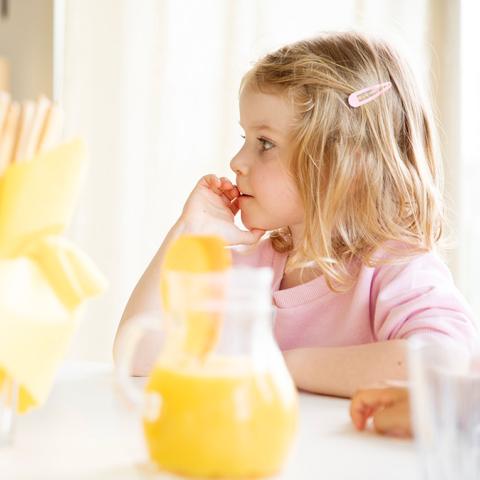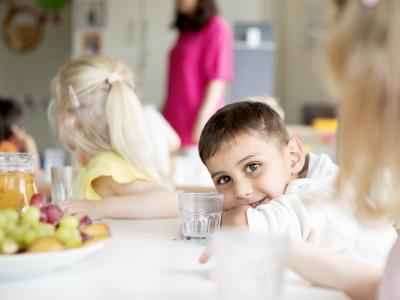
Sport & Spiel at the Wichtel Akademie for the joy of movement
The sports and exercise concept in the Wichtel Akademie kindergarten and crèche
Movement plays a central role in the development of children. It is essential for physical and mental health and should be supported from an early age. This is why we start our exercise program with the crèche children.

Aim and approach of our understanding of movement

- Our approach goes beyond the purely physical promotion of performance. The focus is on the holistic development of the child's personality through movement. Children experience the world through their senses and their bodies. They learn by grasping, crawling, running, climbing and exploring their environment. We create the necessary environment for them to gain a variety of movement experiences.
- Our aim is to allow children to learn about the rules of sporting behavior, as these are closely linked to their understanding of rules in everyday life. Among other things, sporting rules of conduct and their specific structures are an important preparation for school.
What do we want to teach children through exercise?
The focus of our program is the fun of movement - that's why we call it "Sport & Spiel". Playing is the most natural way for children to learn. In this playful setting, we teach important skills that strengthen them in the long term.

Sport in the crèche
Our sports lessons for toddlers are particularly child-oriented. It is important to us that the little ones are allowed to have a say and can express their curiosity in a playful way . In a relaxed atmosphere, we introduce them to the topic of exercise without pressure. The aim is for the children to have fun, let off steam and enjoy coming to the gym. In this way, they develop a positive relationship with sport and exercise.
Procedure of a child-oriented sports lesson (physical education)

Sport in kindergarten
Our kindergarten sports lessons offer the children a structured yet playful introduction to various forms of exercise. Before the lesson starts, the children change into comfortable sportswear, barefoot or with sports shoes, depending on the conditions. They fill their water bottles with water and eagerly await the start of the lesson. A typical sports lesson consists of several phases:
Sports outings
In addition to our on-site exercise programs, we offer exciting sports excursions that give the children new experiences:

- Ice skating: First steps on the ice.
- Bouldering: Playful climbing on low walls.
- Sports field: Free play and running on a large surface.
- Tobogganing: Fun in the snow and first experience of movement in winter.
- Olympics: Small competitions for team spirit and motivation.
- Playgrounds: Exploring and romping around in nature.
These excursions create unforgettable experiences, strengthen team spirit and promote the joy of movement in different contexts.
A look at the Wichtel Akademie's sports excursions
In addition to our on-site exercise programs, we offer exciting sports excursions that give the children new experiences:
Frequently asked questions
What is a movement concept?
A movement concept in kindergartens and crèches is a structured plan that aims to offer children a variety of movement opportunities.
It takes into account the spatial conditions, the materials available and the specific needs of the children. The aim is to support the children's natural urge to move and to strengthen their motor development.
The Wichtel Akademie specifically integrates such concepts in order to offer the children a stimulating environment for their physical development. Recurring rituals in the various targeted movement units create security and structure for the children. In everyday life, as well as in the designed movement concept, the focus is on well-being and "feeling safe". When children feel safe, they can develop and dare to try out more things.
What is part of physical education?
Physical education includes all educational measures aimed at supporting children's motor skills. This includes activities such as climbing, jumping, balancing, dancing and targeted movement games.
These diverse activities address and develop both the children's gross and fine motor skills. The Wichtel Akademie attaches particular importance to regularly integrating these activities into the daycare center's daily routine and thus offering the children a variety of movement stimuli. For example, in addition to the targeted sports and play units, transitions into new situations are introduced with exciting movement games. The children hop on one leg from the checkroom back into the group, turn into snakes crawling on the floor or walk on tiptoe to lunch. All these seemingly "inconspicuous" small steps are exercises and incentives to activate the children to feel their bodies again and again and, incidentally, to get into new everyday situations. The aspect of being able to develop your "own learning environment" or your own good methods for learning also starts with your own awareness. Knowing what the body and mind need to engage in learning situations is also strengthened with movement education. A strong self-confidence, combined with the knowledge of how the body reacts in different situations, is the key to a healthy life with a positive learning attitude.
Which skills are supported during movement?
Movement supports various skills in children. Motor skills are strengthened by improving coordination, balance and strength.
Cognitive skills develop through increased concentration and better spatial awareness.
Social skills also benefit from exercise, as children learn to communicate with each other, show consideration for one another and achieve goals together.
Movement also contributes to emotional development by boosting self-confidence and increasing frustration tolerance. The Wichtel Akademie supports this development through targeted exercise programs and projects that are adapted to the children's needs.
How can you support physical activity in kindergarten?
Movement in kindergarten can be supported in a variety of ways. One possibility is movement construction sites, where the children have various materials at their disposal with which they can create their own movement landscapes.
Regular outdoor and indoor movement games also encourage the children to try out and discover new forms of movement. Movement integrated into everyday life, such as the conscious incorporation of movement into routines, for example through movement songs or short active breaks, also helps to support the children's natural urge to move.
At the Wichtel Akademie, care is taken to integrate movement as an integral part of the daily routine and to offer both structured and free movement times.
Learning through movement - small and large movement sequences are integrated into various activity circles that take place daily. Finger games, movement sequences that stimulate both sides of the brain or circle games in which children take on the roles of animals become "subconscious" sports units. The children immerse themselves in the movement circles and strengthen their fine and gross motor skills.
What does movement mean in education?
In education, movement means more than just physical activity. It is seen as an essential part of child development, as it supports not only physical development, but also cognitive, social and emotional development.
Movement is closely linked to learning, as children gain a better understanding of their environment and acquire new skills through active experiences. The Wichtel Akademie takes a holistic approach that sees movement as a natural and playful form of learning.
What is supported by exercise in children?
Exercise supports children's overall development. Physical activity not only strengthens motor skills, but also has a positive effect on concentration, social behavior and general well-being. Children who exercise regularly are more balanced and can concentrate better. They also learn to assess their strength and consciously perceive their bodies. Movement, the ability to regulate and an awareness of one's own body are essential building blocks for school readiness. Children who are familiar with their bodies, know what they need to learn and how they can learn best, accept themselves as they are, go to school full of self-confidence and carry their strengthened skills in their school bag.
What types of exercise are there for children?
There are different types of exercise that are suitable for children. These include gross motor movements such as running, jumping and climbing, which help to strengthen muscles and improve coordination.
Fine motor movements, such as grasping, painting or crafting, pressure dosing when using pencils and scissors, support dexterity and dexterity.
Rhythmic movements, such as dancing or clapping, help to develop a sense of rhythm and music.
The Wichtel Akademie focuses on supporting these types of movement in a variety of ways to enable the children to develop holistically.
What skills does movement support?
Exercise supports numerous skills in children. These include physical skills such as endurance, strength and dexterity. Cognitive skills are strengthened by supporting concentration, responsiveness and problem-solving strategies.
Social and emotional skills also benefit from exercise, as children learn to cooperate with each other, resolve conflicts and develop confidence in their own abilities through play.
A lack of exercise in children can have serious consequences for their physical, cognitive, social and emotional development. Physically, it can lead to obesity, reduced muscle strength, impaired coordination and an increased risk of postural defects or metabolic disorders.
Cognitively, a lack of exercise impairs concentration and learning behavior, as it promotes blood flow to the brain and supports the absorption of information. A lack of exercise can lead to a shorter attention span and learning difficulties.
Lack of exercise also has negative social and emotional effects. Children miss out on opportunities to develop social skills such as teamwork and consideration. A lack of exercise can also weaken self-confidence and promote social isolation.
In the long term, this increases the risk of maintaining an inactive lifestyle in adulthood. It is therefore important to offer children sufficient opportunities for exercise at an early age.
The children's ability to assess their own limits is strengthened through interesting and constantly rethought exercise units. Coupled with fixed, recurring rituals, the children develop a sense of security in which they feel more and more confident. Confidence also includes being able to say "stop" and becoming aware of their own limits and not feeling ashamed to communicate this. In this safe environment, the courage to dive into the next zone of development develops, as does the self-confidence to stand up for oneself.
What consequences can a lack of exercise have on children?
A lack of exercise can significantly impair children's physical, cognitive and social development. Physically, it leads to obesity, weaker muscles, limited confidence in movement and a reduced sense of balance. The lack of physical experience makes it difficult to learn basic skills such as running or jumping.
Cognitively, a lack of movement affects perception and psychomotor skills, which are crucial for the connection between movement and mental development. This can lead to concentration problems, which have a negative impact on education.
Socially and emotionally, children lack the opportunity to develop self-confidence and test their movement behavior in the group due to a lack of movement. Parents and educators have the task of recognizing movement as a basic need and providing targeted support.
Why is exercise a basic need for children?
Movement is essential for the healthy development of children, as it enables physical experience and strengthens skills such as coordination and balance. It supports perception and contributes to psychomotor development.
Parents and educators should consider movement as a focus in early childhood education, as it strengthens self-confidence and movement safety in addition to physical health. Children always want to be on the move - this is part of their natural development. They want to understand their world through movement and learn through movement. From classic role-playing games to guided movement activities in the group community - at the Wichtel Akademie, movement is encouraged and is used to accompany the children into the next zone of development.
What role does psychomotor skills play in movement education?
Psychomotor skills combine perception, movement and cognitive processes and are an important part of physical education. Teachers and parents have the task of creating movement opportunities that promote physical experience and strengthen the sense of balance and self-confidence.
How can parents and educators support children's physical activity behavior?
Parents and teachers play a key role in supporting healthy physical activity behavior. Varied movement activities in everyday life strengthen movement safety and build self-confidence.
Movement should be seen as an important part of education, as it improves perception, supports psychomotor development and strengthens basic skills. Even simple everyday moments can be actively shaped. For example, the walk home to nursery can be turned into a relaxed stroll on which a wall can be discovered for balancing. The active role modeling, the participation of the teachers in sports units, or even a short sports unit at home, are absorbed by the children and will reflect this in their behavior and their desire to move.